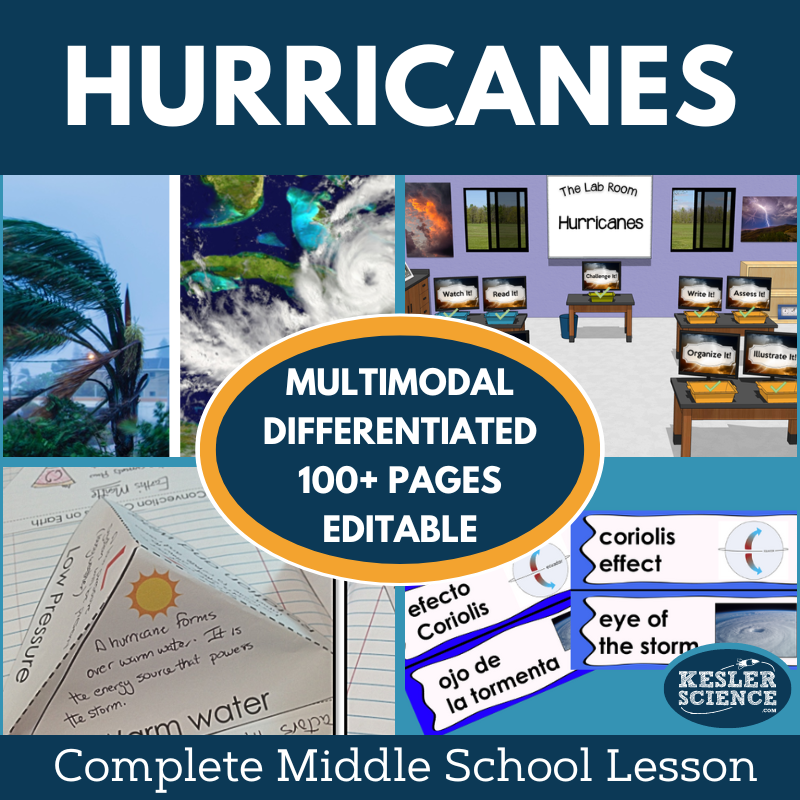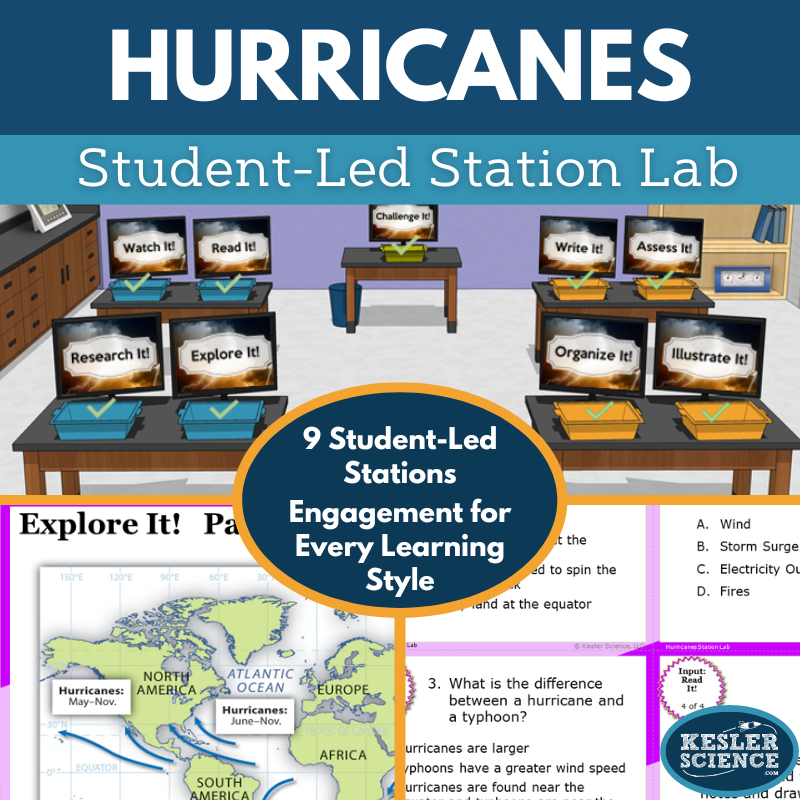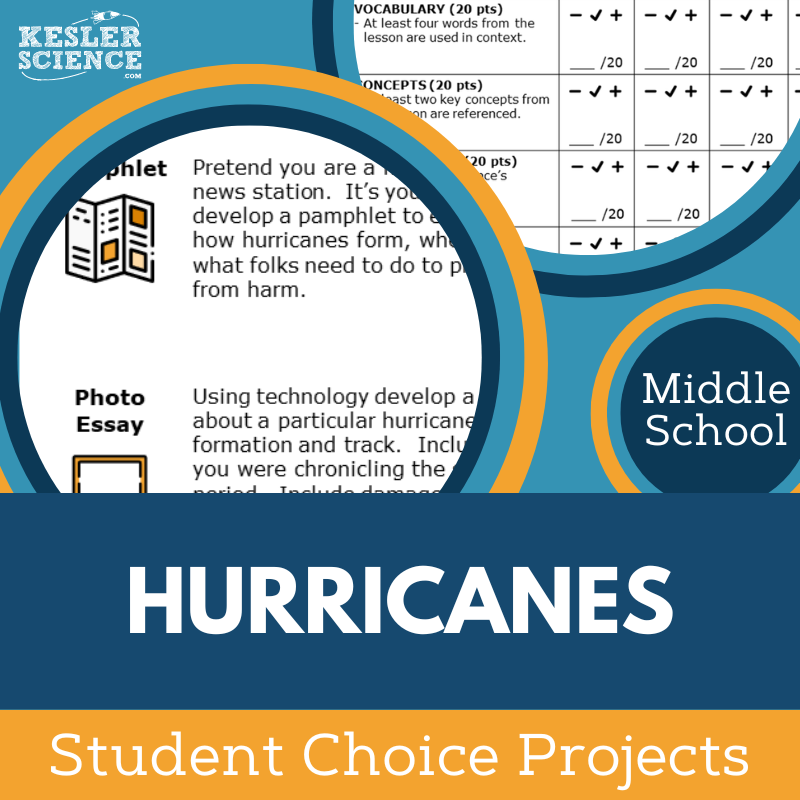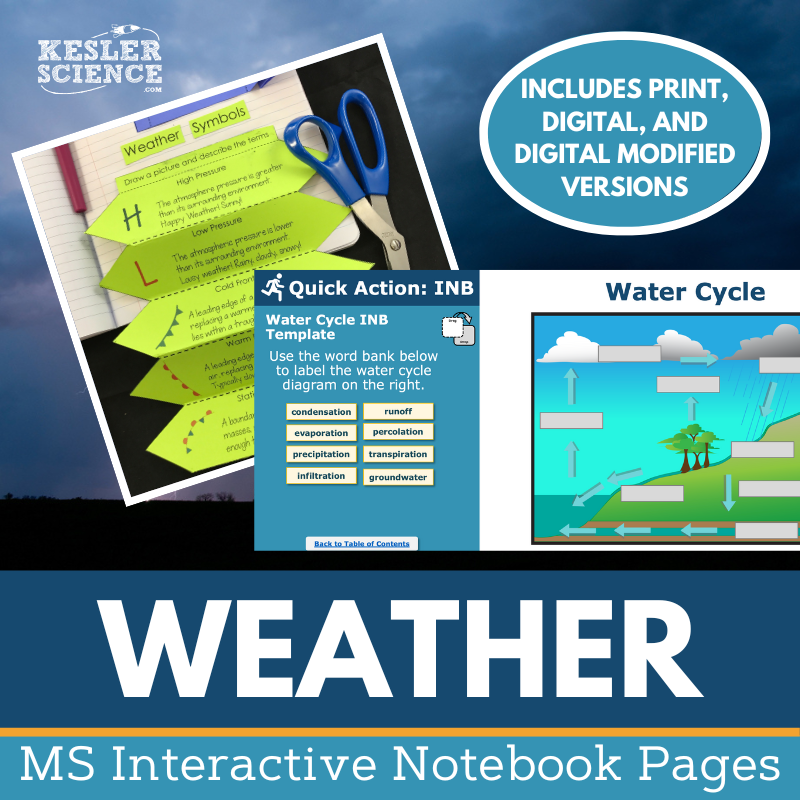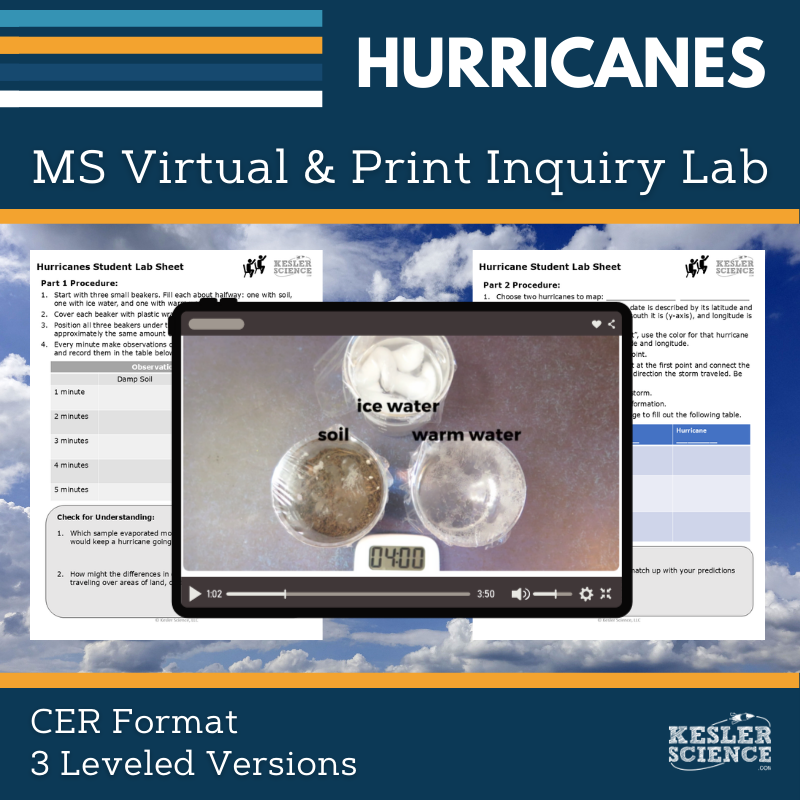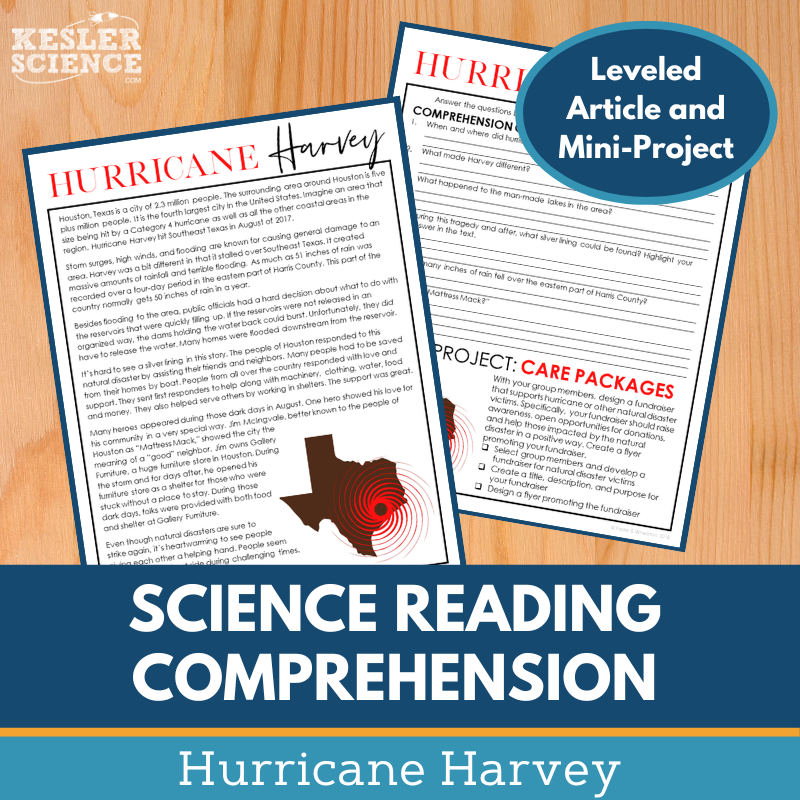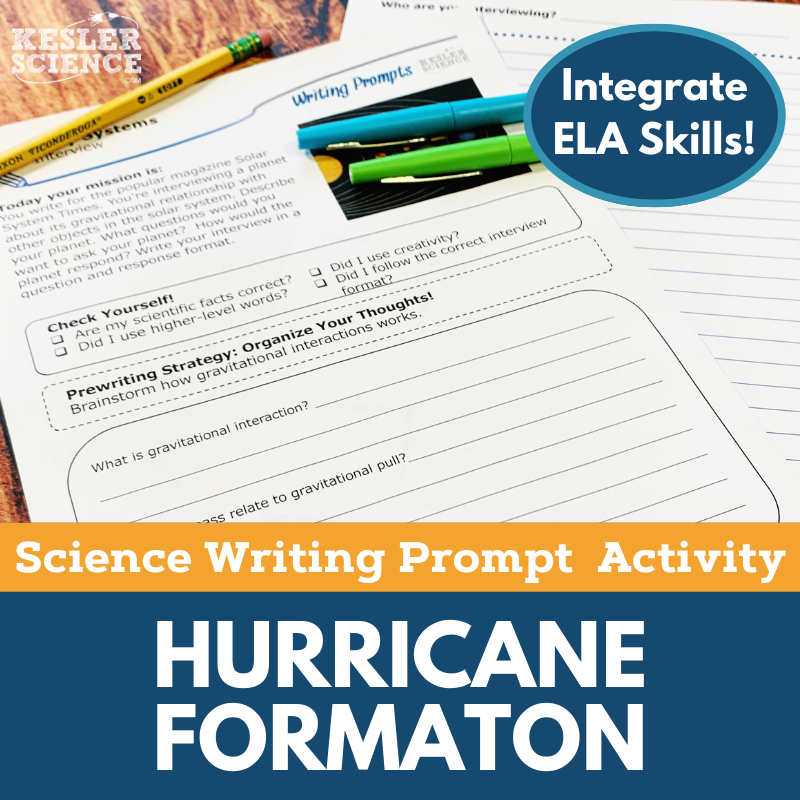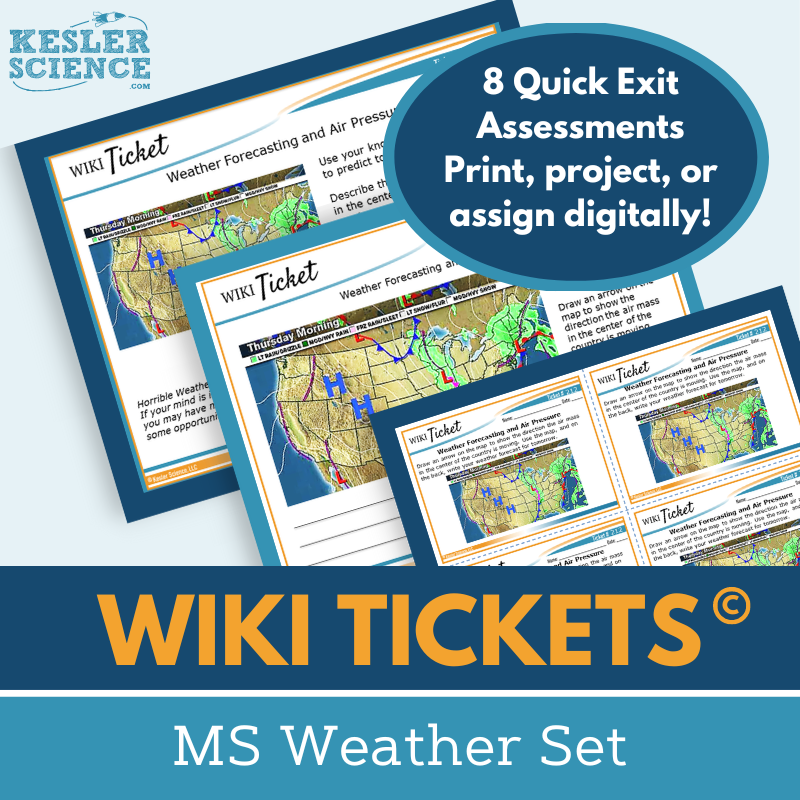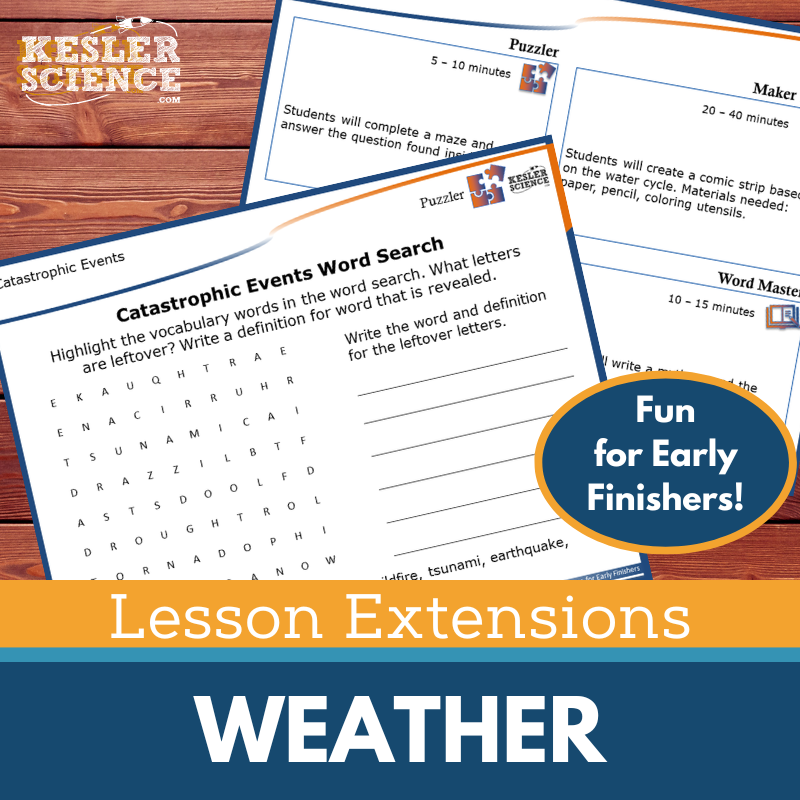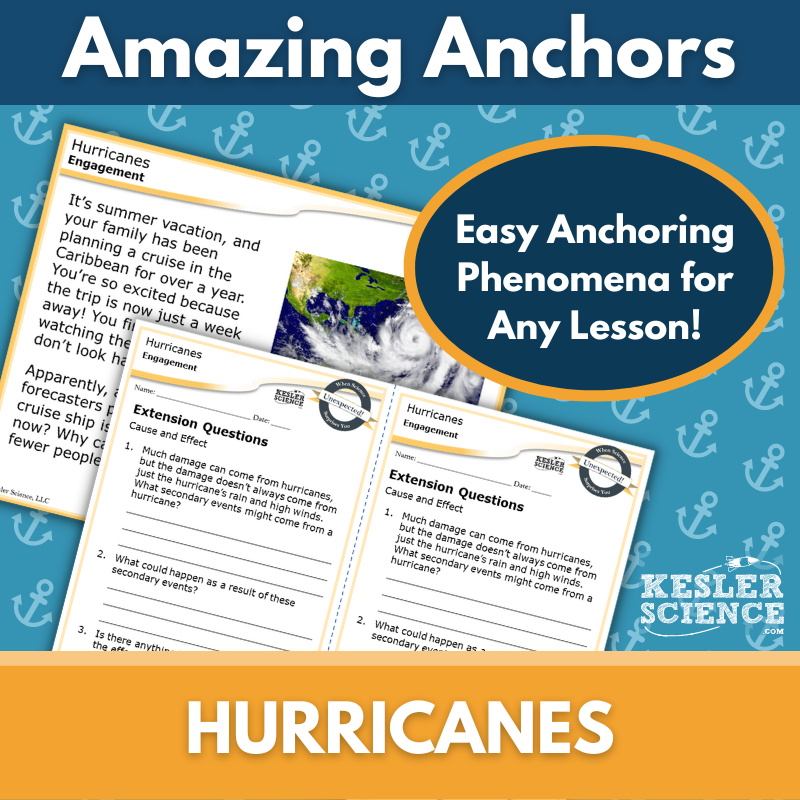Hurricanes Activities for Middle School Science
The Kesler Science Hurricanes Resources provide everything needed to engage middle school students in learning about hurricane formation, tracking, and measurement. The resources below will give students a comprehensive understanding of hurricanes. All of the following materials are also included in the Kesler Science Membership.
The Kesler Science Complete 5E Hurricanes Lesson offers everything needed for an engaging middle school unit on hurricane formation, tracking, and measurement. With editable presentations, worksheets, assessments, and student-choice projects, this multiday lesson requires minimal prep while supporting differentiated, student-led learning. Students will explore essential questions such as the role of oceans in weather systems and how hurricanes are formed, tracked, and measured.
Aligned with the 5E Model, the lesson includes engaging word wall cards, exploratory station labs, editable PowerPoints, and interactive notebook templates in English and Spanish. Exploration activities include hands-on demos, research tasks, videos, and differentiated reading passages, while output activities let students illustrate, write, and organize their knowledge. A bonus Challenge It! station ensures enrichment opportunities for advanced learners.
Designed for both in-person and virtual learning, this resource offers maximum flexibility, with printable and digital formats available. Teachers can focus on facilitating discovery while students deepen their understanding of hurricanes through dynamic, multimodal, and personalized learning experiences.
The Kesler Science Complete 5E Hurricanes Lesson offers everything needed for an engaging middle school unit on hurricane formation, tracking, and measurement. With editable presentations, worksheets, assessments, and student-choice projects, this multiday lesson requires minimal prep while supporting differentiated, student-led learning. Students will explore essential questions such as the role of oceans in weather systems and how hurricanes are formed, tracked, and measured.
Aligned with the 5E Model, the lesson includes engaging word wall cards, exploratory station labs, editable PowerPoints, and interactive notebook templates in English and Spanish. Exploration activities include hands-on demos, research tasks, videos, and differentiated reading passages, while output activities let students illustrate, write, and organize their knowledge. A bonus Challenge It! station ensures enrichment opportunities for advanced learners.
Designed for both in-person and virtual learning, this resource offers maximum flexibility, with printable and digital formats available. Teachers can focus on facilitating discovery while students deepen their understanding of hurricanes through dynamic, multimodal, and personalized learning experiences.
In the Kesler Science Hurricanes Station Lab, students take charge of their learning by rotating through nine stations designed to investigate the causes, impacts, and patterns of hurricanes. These stations include input activities, like hands-on demonstrations, research tasks, reading comprehension, and videos, as well as output activities, such as organizing information, creating illustrations, writing responses, and assessing understanding. Students work independently or in small groups, fostering a personalized and student-led learning experience.
The lab features eight core stations, plus a bonus "Challenge It!" station for early finishers. Each station includes signage, resources, and task cards to guide students. Input stations like “Explore It!” offer hands-on engagement, while “Research It!” and “Read It!” provide content in digital or printable formats. Output stations like “Write It!” and “Illustrate It!” encourage students to communicate their knowledge effectively, making the learning experience dynamic and interactive.
This station lab is adaptable for in-person and virtual classrooms, with many activities available digitally through PowerPoint or Google Slides. With minimal prep, teachers can facilitate an engaging and differentiated exploration of hurricanes, allowing students to deepen their understanding of weather systems through inquiry and discovery.
In the Kesler Science Hurricanes Station Lab, students take charge of their learning by rotating through nine stations designed to investigate the causes, impacts, and patterns of hurricanes. These stations include input activities, like hands-on demonstrations, research tasks, reading comprehension, and videos, as well as output activities, such as organizing information, creating illustrations, writing responses, and assessing understanding. Students work independently or in small groups, fostering a personalized and student-led learning experience.
The lab features eight core stations, plus a bonus "Challenge It!" station for early finishers. Each station includes signage, resources, and task cards to guide students. Input stations like “Explore It!” offer hands-on engagement, while “Research It!” and “Read It!” provide content in digital or printable formats. Output stations like “Write It!” and “Illustrate It!” encourage students to communicate their knowledge effectively, making the learning experience dynamic and interactive.
This station lab is adaptable for in-person and virtual classrooms, with many activities available digitally through PowerPoint or Google Slides. With minimal prep, teachers can facilitate an engaging and differentiated exploration of hurricanes, allowing students to deepen their understanding of weather systems through inquiry and discovery.
In the Kesler Science Hurricanes Student Choice Projects, middle school students explore hurricane concepts through creative, student-led projects. A project page outlines six options plus a "design your own" project, empowering students to express their understanding in a way that suits their learning style. A flexible grading rubric supports teacher, peer, or self-assessment, emphasizing vocabulary, clarity, and accuracy.
This differentiated resource includes two project page versions to meet diverse needs. The modified version offers simpler tasks for students requiring additional support, while advanced learners can tackle multiple projects for an extra challenge. Teachers have the option to adapt rubrics and projects to fit classroom goals and student readiness.
Designed for flexibility, these projects utilize standard classroom supplies and allow for digital or hands-on completion. With a focus on creativity and personalized learning, this resource is ideal for fostering engagement, deep understanding, and self-expression in earth science lessons.
In the Kesler Science Hurricanes Student Choice Projects, middle school students explore hurricane concepts through creative, student-led projects. A project page outlines six options plus a "design your own" project, empowering students to express their understanding in a way that suits their learning style. A flexible grading rubric supports teacher, peer, or self-assessment, emphasizing vocabulary, clarity, and accuracy.
This differentiated resource includes two project page versions to meet diverse needs. The modified version offers simpler tasks for students requiring additional support, while advanced learners can tackle multiple projects for an extra challenge. Teachers have the option to adapt rubrics and projects to fit classroom goals and student readiness.
Designed for flexibility, these projects utilize standard classroom supplies and allow for digital or hands-on completion. With a focus on creativity and personalized learning, this resource is ideal for fostering engagement, deep understanding, and self-expression in earth science lessons.
The Kesler Science Weather Interactive Notebook Bundle offers both print and digital versions to enhance student engagement while teaching key weather concepts. Perfect for traditional classrooms, 1:1 settings, or distance learning, this bundle covers important topics such as the atmosphere, catastrophic events, convection currents, hurricane formation, the water cycle, and weather maps.
Digital versions include a customizable PowerPoint file that can be uploaded to Google Slides or integrated into platforms like MS Teams, Schoology, and Canvas. It also features reflection pages, spaces for student notes, and a modified version for students with accommodations, all supported by a teacher answer key.
The paper version includes complete blank templates for the interactive notebook, pre-filled versions for students needing modifications or those who missed class, and color photos that demonstrate how each template is used, making it a versatile tool for teachers and students alike.
The Kesler Science Weather Interactive Notebook Bundle offers both print and digital versions to enhance student engagement while teaching key weather concepts. Perfect for traditional classrooms, 1:1 settings, or distance learning, this bundle covers important topics such as the atmosphere, catastrophic events, convection currents, hurricane formation, the water cycle, and weather maps.
Digital versions include a customizable PowerPoint file that can be uploaded to Google Slides or integrated into platforms like MS Teams, Schoology, and Canvas. It also features reflection pages, spaces for student notes, and a modified version for students with accommodations, all supported by a teacher answer key.
The paper version includes complete blank templates for the interactive notebook, pre-filled versions for students needing modifications or those who missed class, and color photos that demonstrate how each template is used, making it a versatile tool for teachers and students alike.
The Hurricane Inquiry Lab aligns with the NGSS by helping students explore how oceans influence hurricanes. Students will track the paths of historic hurricanes and analyze patterns to draw conclusions about hurricane formation and movement. Both digital and print versions include comprehension questions, C.E.R. prompts, and a reflection section to support three-dimensional learning.
This resource includes three differentiated versions—dependent, modified, and independent—to support a range of learning needs. The dependent version guides students with structured instructions and inquiry questions, the modified version simplifies the content and adds scaffolds like sentence stems, and the independent version allows advanced students to lead their own learning with minimal support.
In the hands-on version, students use plastic wrap, beakers, ice and warm water, dirt, and a heat lamp to simulate hurricane conditions. The digital version includes fully interactive activities with no additional materials required, making it ideal for absent students or remote learning. Editable files, teacher keys, and built-in flexibility make this a valuable resource for any classroom setting.
The Hurricane Inquiry Lab aligns with the NGSS by helping students explore how oceans influence hurricanes. Students will track the paths of historic hurricanes and analyze patterns to draw conclusions about hurricane formation and movement. Both digital and print versions include comprehension questions, C.E.R. prompts, and a reflection section to support three-dimensional learning.
This resource includes three differentiated versions—dependent, modified, and independent—to support a range of learning needs. The dependent version guides students with structured instructions and inquiry questions, the modified version simplifies the content and adds scaffolds like sentence stems, and the independent version allows advanced students to lead their own learning with minimal support.
In the hands-on version, students use plastic wrap, beakers, ice and warm water, dirt, and a heat lamp to simulate hurricane conditions. The digital version includes fully interactive activities with no additional materials required, making it ideal for absent students or remote learning. Editable files, teacher keys, and built-in flexibility make this a valuable resource for any classroom setting.
This Science Reading Comprehension Lesson introduces middle school students to the role of oceans in the formation of weather systems such as hurricanes. Students read a nonfiction, leveled article and answer 5–7 comprehension questions to build both science literacy and reading comprehension. A hands-on mini-project lets students create their own density experiment to reinforce the science content.
The resource includes two leveled articles (Lexile 1100–1300), colorful graphics, and a Cornell notes template. Designed for grades 6–8 and high-achieving 5th graders, this lesson provides a flexible way to engage students through textual analysis and scientific reasoning. The printable and digital versions make it easy to integrate into notebooks or project virtually in class.
Ideal for sub plans, extra credit, or whole-class instruction, this resource works in both in-person and distance learning environments, including platforms like Google Classroom and Canvas. Whether used as part of a routine or to support a specific topic, the article supports rich classroom discussion and deeper understanding of weather systems.
The Science Reading Comprehension Lesson introduces middle school students to the role of oceans in the formation of weather systems such as hurricanes. Students read a nonfiction, leveled article and answer 5–7 comprehension questions to build both science literacy and reading comprehension. A hands-on mini-project lets students create their own density experiment to reinforce the science content.
The resource includes two leveled articles (Lexile 1100–1300), colorful graphics, and a Cornell notes template. Designed for grades 6–8 and high-achieving 5th graders, this lesson provides a flexible way to engage students through textual analysis and scientific reasoning. The printable and digital versions make it easy to integrate into notebooks or project virtually in class.
Ideal for sub plans, extra credit, or whole-class instruction, this resource works in both in-person and distance learning environments, including platforms like Google Classroom and Canvas. Whether used as part of a routine or to support a specific topic, the article supports rich classroom discussion and deeper understanding of weather systems.
The Kesler Science Hurricane Formation Writing Prompt Activity engages middle school students in exploring earth science through a creative news event report format. Students test their knowledge of hurricane formation while enhancing their science reasoning and writing skills. The activity includes pre-writing strategies, self-check tools, and templates, making it perfect for in-class or virtual learning environments.
This low-prep, high-quality resource integrates seamlessly with other Kesler Science products and works as an elaboration activity, formative assessment, or student choice project. Teachers receive full and half-sheet handouts, rubrics, and a digital interactive version for flexible use across various settings and learner needs.
Ideal for cross-curricular learning, early finishers, extra credit, or differentiation exercises, this activity enriches writing while fostering critical thinking about hurricane formation. Its versatile design ensures students stay engaged and actively apply their science knowledge in a meaningful way.
The Kesler Science Hurricane Formation Writing Prompt Activity engages middle school students in exploring earth science through a creative news event report format. Students test their knowledge of hurricane formation while enhancing their science reasoning and writing skills. The activity includes pre-writing strategies, self-check tools, and templates, making it perfect for in-class or virtual learning environments.
This low-prep, high-quality resource integrates seamlessly with other Kesler Science products and works as an elaboration activity, formative assessment, or student choice project. Teachers receive full and half-sheet handouts, rubrics, and a digital interactive version for flexible use across various settings and learner needs.
Ideal for cross-curricular learning, early finishers, extra credit, or differentiation exercises, this activity enriches writing while fostering critical thinking about hurricane formation. Its versatile design ensures students stay engaged and actively apply their science knowledge in a meaningful way.
The Kesler Science Weather WIKI Tickets are engaging formative assessments designed for 6th-8th grade science topics, offering flexible options for checking student understanding. The Weather Set includes eight WIKI Tickets, each aligned to NGSS and TEKS standards, with five format choices: a projection version, three handout sizes (full, split, and quarter-page), and a digital version (editable PPT or Google Slides). These assessments provide a fun, interactive way to gauge student learning.
The WIKI Tickets can be used as exit tickets, bellringers, or during lessons to quickly assess students' grasp of concepts such as the water cycle, weather maps, and ocean currents. Each ticket helps reinforce key topics, ensuring that students are meeting learning goals in a creative, low-pressure way. A bonus table of contents file is included for easy reference to ensure standards alignment.
Perfect for both in-person and virtual learning, these assessments allow for seamless integration into various classroom settings. Whether projected in class or completed digitally, WIKI Tickets help educators gauge student progress and adapt instruction to meet their needs.
The Kesler Science Weather WIKI Tickets are engaging formative assessments designed for 6th-8th grade science topics, offering flexible options for checking student understanding. The Weather Set includes eight WIKI Tickets, each aligned to NGSS and TEKS standards, with five format choices: a projection version, three handout sizes (full, split, and quarter-page), and a digital version (editable PPT or Google Slides). These assessments provide a fun, interactive way to gauge student learning.
The WIKI Tickets can be used as exit tickets, bellringers, or during lessons to quickly assess students' grasp of concepts such as the water cycle, weather maps, and ocean currents. Each ticket helps reinforce key topics, ensuring that students are meeting learning goals in a creative, low-pressure way. A bonus table of contents file is included for easy reference to ensure standards alignment.
Perfect for both in-person and virtual learning, these assessments allow for seamless integration into various classroom settings. Whether projected in class or completed digitally, WIKI Tickets help educators gauge student progress and adapt instruction to meet their needs.
The Kesler Science Lesson Extensions provide engaging, rigorous activities designed to challenge fast finishers and deepen student understanding. These extensions offer a variety of options, including puzzles, hands-on maker space activities, tech connections, and creative writing, all linked to the weather standards of NGSS and TEKS. Whether you're looking to end a lesson or fill gaps during testing, these activities keep students actively learning while promoting critical thinking.
Each extension includes teacher directions, answer keys, and printable or digital versions for easy classroom integration. The diverse formats allow students to work individually or collaborate, fostering creativity and independent learning. The resources are ideal for pushing students who are ready for more advanced learning, encouraging them to explore topics like catastrophic events, hurricane formation, and the water cycle.
Perfect for use with any of the Kesler Science weather lessons, these extensions help reinforce key concepts while offering a fun and meaningful challenge. With options for both digital and paper use, they are a flexible way to scaffold learning and support students’ growth.
The Kesler Science Lesson Extensions provide engaging, rigorous activities designed to challenge fast finishers and deepen student understanding. These extensions offer a variety of options, including puzzles, hands-on maker space activities, tech connections, and creative writing, all linked to the weather standards of NGSS and TEKS. Whether you're looking to end a lesson or fill gaps during testing, these activities keep students actively learning while promoting critical thinking.
Each extension includes teacher directions, answer keys, and printable or digital versions for easy classroom integration. The diverse formats allow students to work individually or collaborate, fostering creativity and independent learning. The resources are ideal for pushing students who are ready for more advanced learning, encouraging them to explore topics like catastrophic events, hurricane formation, and the water cycle.
Perfect for use with any of the Kesler Science weather lessons, these extensions help reinforce key concepts while offering a fun and meaningful challenge. With options for both digital and paper use, they are a flexible way to scaffold learning and support students’ growth.
This Amazing Anchors Phenomenon Lesson introduces and reinforces the science of hurricanes through a relatable real-world connection. Students begin with an introductory reading centered on a disrupted family vacation, using comprehension and extension questions to build curiosity and prepare for deeper learning. An explanatory reading follows, breaking down how hurricanes form and providing additional questions to help students make sense of the underlying science.
The lesson includes everything teachers need to seamlessly incorporate it into their classroom, such as detailed directions, answer keys, projection slides, and editable digital and print formats. Full- and half-sheet handouts are provided for interactive notebooks, and the materials are fully aligned to TEKS standards.
Designed to bookend any hurricane-related lesson, this no-prep resource supports both engagement and elaboration phases of the 5E model. It includes differentiated versions to support diverse learners, including a modified version with scaffolded language and sentence starters. The resource is ideal for in-person or digital use through Google Classroom or other LMS platforms.
This Amazing Anchors Phenomenon Lesson introduces and reinforces the science of hurricanes through a relatable real-world connection. Students begin with an introductory reading centered on a disrupted family vacation, using comprehension and extension questions to build curiosity and prepare for deeper learning. An explanatory reading follows, breaking down how hurricanes form and providing additional questions to help students make sense of the underlying science.
The lesson includes everything teachers need to seamlessly incorporate it into their classroom, such as detailed directions, answer keys, projection slides, and editable digital and print formats. Full- and half-sheet handouts are provided for interactive notebooks, and the materials are fully aligned to TEKS standards.
Designed to bookend any hurricane-related lesson, this no-prep resource supports both engagement and elaboration phases of the 5E model. It includes differentiated versions to support diverse learners, including a modified version with scaffolded language and sentence starters. The resource is ideal for in-person or digital use through Google Classroom or other LMS platforms.
Year-Round Resources
These year-round activities will increase your students' understanding of many middle school science topics. All of these activities are also included in the Kesler Science Membership.
Visual Data & Graphing
You're not alone if your students struggle with understanding graphs, charts, and tables. It's a skill that takes an enormous amount of practice. This resource will help students build a strong foundation in analyzing data and creating their own data visualizations.
Bell Ringers and Warm-Ups
These middle school science bell ringers are an excellent way to engage your students as soon as they walk into your classroom. This comprehensive FULL YEAR resource includes everything you need to start off each science class with an interesting warm-up activity.
Review Board Games
Each game board has been carefully designed to keep students engaged. There are 10 different action spaces on each board and dozens of question cards. All of the actions are related to science concepts and keep the students motivated throughout the game.
Each game is ready to play. Simply print out the board and the cards and let the students enjoy reviewing nine different units.
Essential Questions
Below are the essential questions associated with the lessons and activities included in this unit. This topic is only one of more than 100 middle school science topics included in the Kesler Science Membership.
-
What part do oceans play in the formation of weather systems such as hurricanes?
-
How are hurricanes formed, measured, and tracked?
Kesler Science Membership
Imagine never having to search for another middle school science lesson again. The membership gives you access to ALL of the Kesler Science products in one place (Yes, including everything above).
Say goodbye to long hours of lesson prep.

